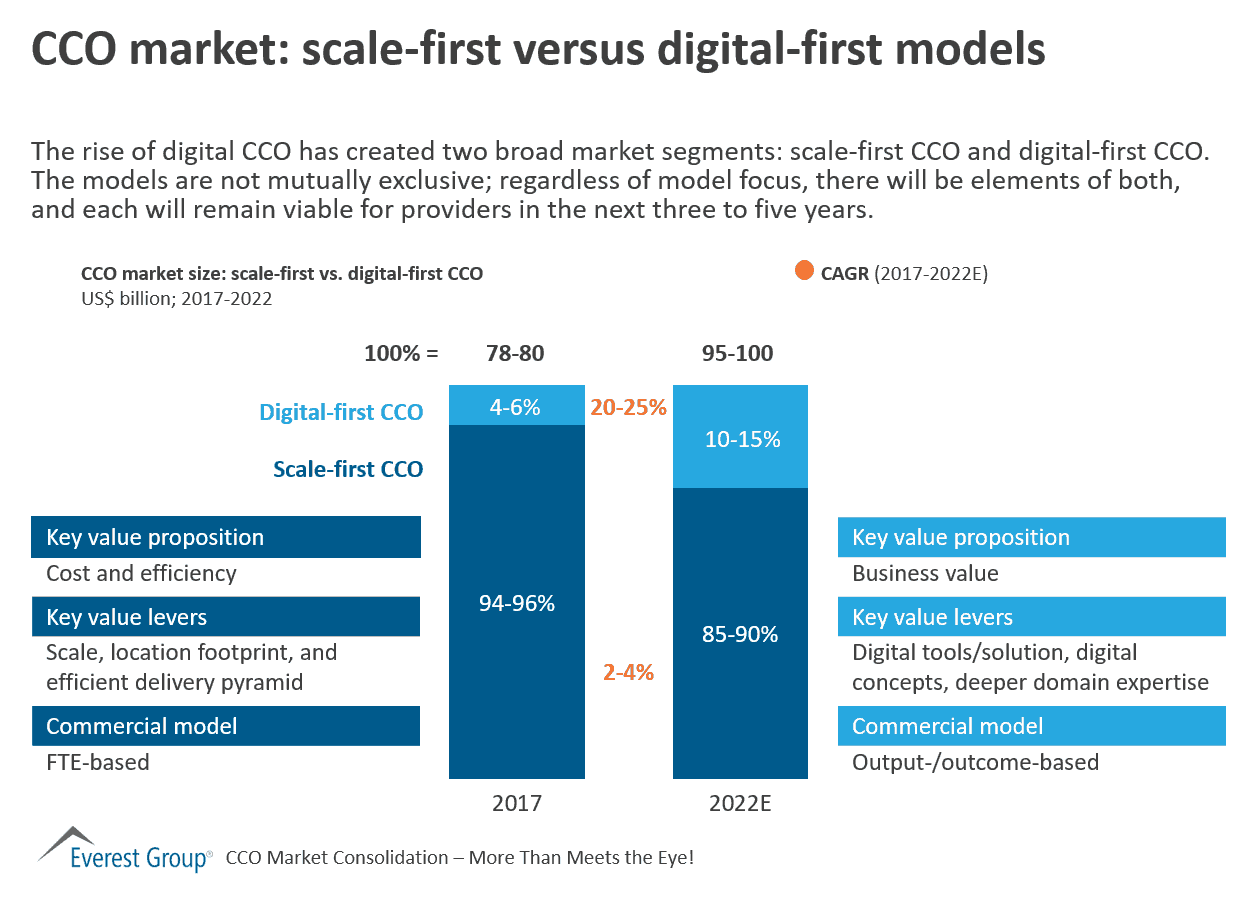
CCO market: scale-first versus digital-first models
The rise of digital CCO has created two broad market segments: scale-first CCO and digital-first CCO. The models are not mutually exclusive; regardless of model focus, there will be elements of both, and each will remain viable for providers in the next three to five years.

Global services in South Africa – headcount, services, and key companies
Learn more about our service delivery location services research
Everest Group is once again the featured Knowledge Partner of the 2018 Contact Islands conference, “Leading with CX in a Digital World,” presented by the Contact Center Association of the Philippines (CCAP).
Managing Partner Eric Simonson and Research Partner H. Karthik will be key speakers during the event.
Eric will lead a session titled, “The Empowered Customer in the Age of Digital Care”
Session summary: Industries across the globe are facing profound paradigm shifts driven by new business models, supported by innovative, disruptive innovations. Amidst the changing business landscape, the focus on customers has become even more critical than ever before. This session aims to build a better understanding of the “new-age” customer and their expectations, focusing on both existing customer segments as well as millennials. The session re-inforces the importance of staying focused on customers while in the midst of adopting new models and undergoing transformation.
Karthik will moderate a session titled, “Gearing Up for the Hybrid Workforce: Humans + Machines”
Session summary: Next gen technologies such as AI, automation, and advanced analytics is changing the way companies operates. As humans and machines work more closely and collaborate, processes can become more fluid and adaptive and help organizations become more innovative and profitable. This session brings in the views of the leading industry voices on how they are getting ready for this shift and the kind of the steps they are taking, including the changes coming to the overall CX approach. Further, it explores how the collaborative Human + Machine service delivery model will enhance outcomes and result in more impact than ever before.
July 25-26, 2018
Shangri-La’s Mactan Resort and Spa
Cebu, Philippines
Eric Simonson, Managing Partner, Everest Group
H. Karthik, Partner, Research, Everest Group
There’s no shortage of market discussion around a wide range of customer experience (CX) opportunities and challenges. It’s what everyone in your organization, from IT, to HR, to actual customer care, are talking about. But while ideas about what you should be trying to achieve and why you should care abound, insight on how to actually execute and what delivery outcomes to target is hard to come by.
One approach drawing attention involves the use of contact center outsourcing (CCO) services. The traditional “butts-in-seats” model is evolving to more of a customer experience management (CXM) service model, where outcomes are assessed for impact as much as for cost management. The traditional view has been that the primary value delivered by CCO providers is operational cost savings through efficiencies, labor arbitrage, and scale. But that’s no longer enough. An increasing number of enterprises are raising the bar and looking to their CCO providers for an expanded value proposition targeting digitally-enabled and differentiated CX capabilities. We refer to this engagement approach as Customer Experience Management (CXM) services.
We believe that companies really serious about reshaping their brand through memorable CX are more often turning to this new model of CXM services. We call this breed of buyers CX Outsourcing Pinnacle EnterprisesTM. And we believe these enterprises are very intentionally leveraging these advanced CXM services to enhance their corporate-wide CX strategies, and to achieve results more quickly and at lower costs.
We’ve launched a unique study to dig deep and identify how these Pinnacle Enterprises engage CXM services to drive both operational and strategic imperatives for their overall CX strategy. How can this emerging model help enterprises tackle high-value CX objectives such as digital enablement, greater insights on and visibility into consumer wants and behaviors, increased wallet share, and reduced customer effort? What are the mechanisms in play around technology, governance, talent models, pricing models, and others?
This is an all-around different approach to CXM services – a rethinking of which outcomes to target, what to measure, the role of technology, and the new relationship model.
Curious to know what leading CX Outsourcing Pinnacle Enterprises are doing? Want to know where your organization stands compared to others? Everest Group invites you to become part of the research process and take our survey.
Customers have stopped thinking about channels. It’s the experience that matters to them now – regardless of the channel they choose at any point of time. Thus, it’s no surprise that 73 percent of buyers responding to Everest Group’s 2016/17 Contact Center Outsourcing (CCO) surveys and interviews rated omnichannel as their top priority for adoption, and that 23 percent of buyers want to integrate the face-to-face customer touchpoints with their contact centers.
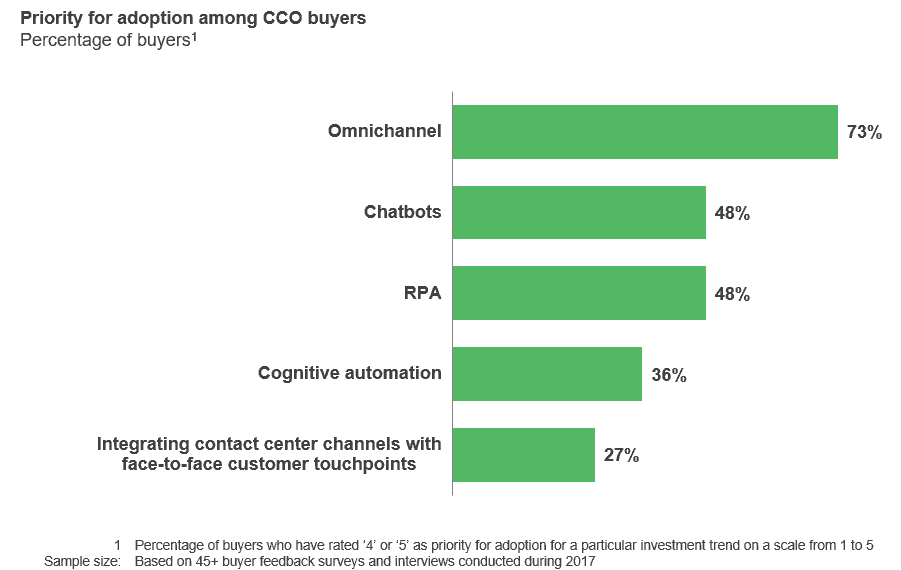
Regardless of this intention, very few enterprises have achieved delivering a true omnichannel experience or built competitive advantage through exceptional CX.
Challenge 1: Lack of strategic leadership support: Most omnichannel transition efforts lack direct involvement from senior leadership to prioritize investments, communicate urgency for transition, and mitigate any implementation roadblocks. This contributes to misplaced priorities and execution inefficiencies.
Solution: An internal transition team consisting of experienced senior leadership can be set up to manage and drive the organization-wide change towards omnichannel.
Challenge 2: Inadequate focus on human capital challenges: Omni-channel investment decisions are primarily focused on technologies and solutions. But even with sophisticated tools and technologies in place, lack of investment in human capital makes it difficult to practically achieve the desired outcomes.
Solution: Organizations need to place equal importance on investments in human capital and begin their omnichannel transition efforts by assessing the talent requirements to manage omnichannel CX.
Challenge 3: Organizational skills gap for omnichannel: IT teams often lack the necessary skills to support the integration of tools, channels, and databases. Contact center managers also require upskilling on sophisticated technologies, systems, and processes to effectively manage omnichannel contact centers. Agents, usually trained in supporting individual channels, have limited knowledge to work across multiple channels.
Solution: Enterprises should conduct a gap analysis to identify training requirements for the existing talent at all levels of the organization, with the necessary skills for omni-channel and hire for new profiles. They should also revise employee performance metrics and align the incentives with common omnichannel KPIs
Challenge 4: Historically siloed functions and channels: Lack of integrated front-office functions such as sales, marketing, and customer service with back-office functions such as business intelligence, reporting, procurement, inventory management, etc., makes it impossible to create a unified view about customers.
Solution: Back-to-front office integration is crucial for a great end-to-end customer journey. The first step to achieving this is through customer journey mapping for all end-to-end processes to identify changing behaviors, capture unmet expectations, optimize processes, and encourage cross-functional collaboration.
Challenge 5: Lack of clarity on requirements for data integration from all channels: Enterprises are not clear about the business and operational needs to support data integration across all channels. Management of disparate CRM, voice and other technology systems also hinder integration.
Solution: Enterprises need to assess the implications of data standardization and integration across channels and identify an appropriate mix of tools to achieve integration of disparate datasets and applications.
Challenge 6: Incompatible legacy systems: Most legacy systems in enterprises, especially CRM systems and voice technologies, are incompatible with omnichannel platforms and solutions. This leads to inconsistency in capturing and transferring data to achieve a unified view of customers in a single platform.
Solution: Enterprises should adopt non-invasive omnichannel platforms and solutions that can seamlessly communicate with their legacy systems.
To learn more, check out Everest Group’s two-part study on omnichannel customer experience: “From Multi-Channel to Omni-Channel Customer Experience,” and “Delivering Omni-Channel Customer Experience.” Both include checklists to help enterprises successfully plan and execute their transition to omnichannel. And, please feel free to share your omnichannel experiences with us: Katrina Menzigian ([email protected]) and Jayapriya K ([email protected].)
Digital is driving dramatic changes to the contact center outsourcing (CCO) industry. Indeed, our recently completed buyer study – conducted over three years via surveys with more than 140 organizations and a large number of executive interviews – made it abundantly clear that outsourcing drivers are shifting away from the traditional (such as cost savings) to a digital orientation for capabilities such as analytics, access to better technology, and multi-channel solutions. Buyers now expect a lot more from their CCO engagements to delight their digitally-savvy customers.
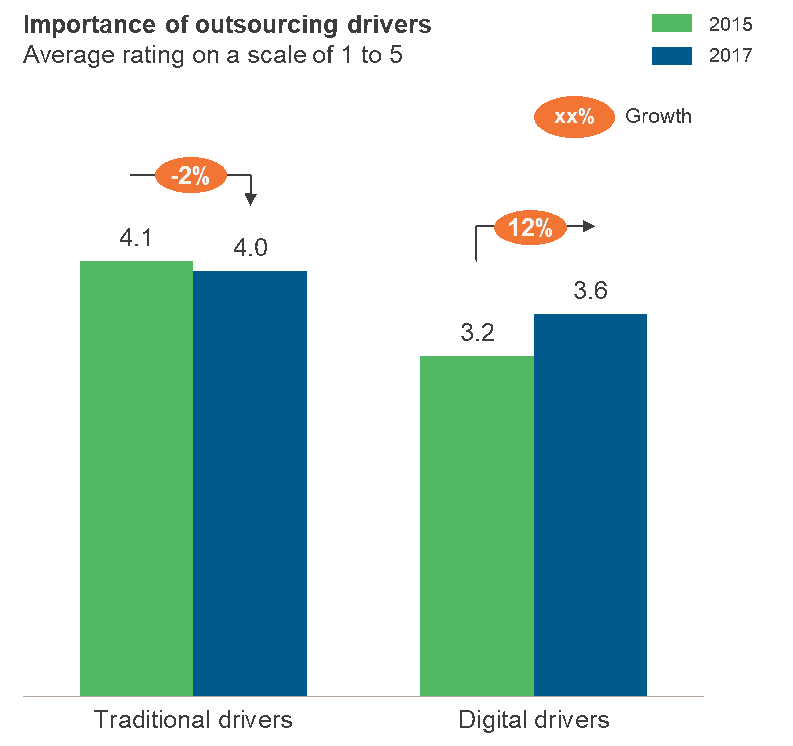
While the importance of digital drivers has risen, service provider performance has remained below par on the new-age KPIs such as innovation, better insights, and proactiveness. As enterprises are now looking to associate with providers that are customer-centric, innovative, flexible, and able to serve as long-term strategic partners in their growth, providers must differentiate themselves by focusing their attention on improving their performance in these areas.
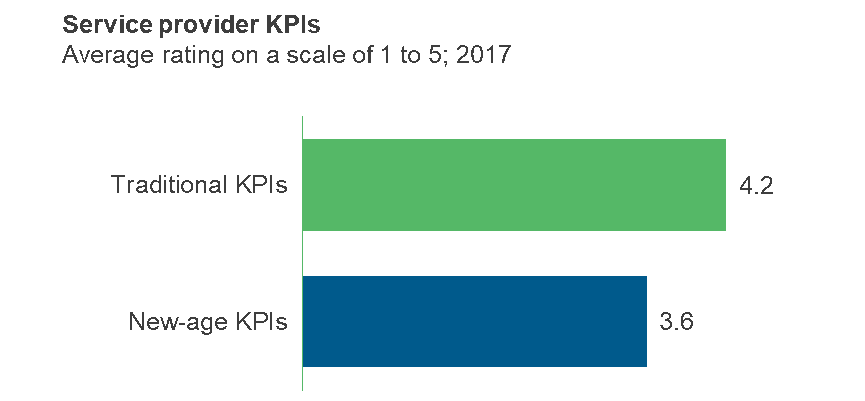
So, what do providers need to do to cater to these changes in buyer expectations and, in turn, survive in the fast-evolving contact center outsourcing industry? Here are our three key action steps:
To learn more about the evolving contact center buyer expectations and the corresponding provider performance, please read our recently released CCO Market Report 2017: “How Good are CCO Providers in Providing Digital Customer Experience.”
Enterprises and their contact center operations are increasingly adopting self-service technologies to improve the customer experience. Over the past several years, chatbots have become one of the most embraced. And it’s easy to see why.
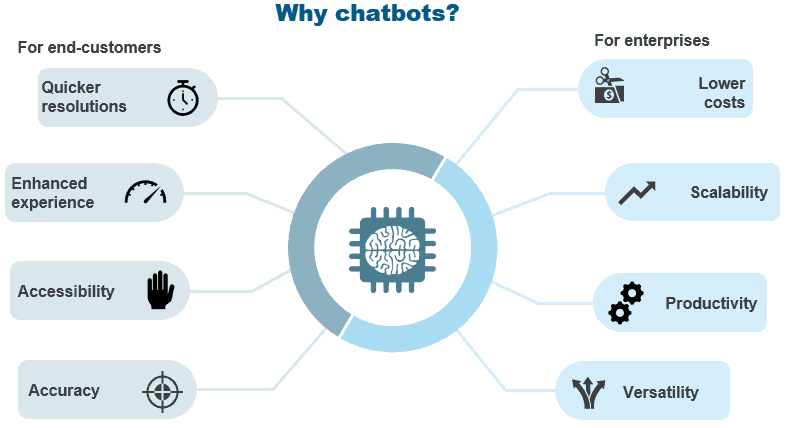
First generation chatbots were software programs that could hold a natural conversation on a text-based channel such as chat, email, or social media. Modern day chatbots’ capabilities – interchangeably called virtual agents – have leapfrogged ahead through use of Artificial Intelligence (AI), machine learning, and Natural Language Processing (NLP), which allow them to understand free flowing language and generate real-time responses. They are no longer bound to a single channel, but instead cover the entire ambit of services, including voice support. This helps them fit well with enterprises’ broader omnichannel strategy, as they can deliver a seamless experience across channels.

Unlike earlier versions, today’s chatbots can even contextualize information in a conversation. Here’s an example:
Jim: I would like to know the status of my flight. It’s booking # PNR AZ12356.
Chatbot: Hi Jim, checking into it. It appears that your flight’s departure will be delayed by 4 hours, due to scheduling changes.
Jim: Can you cancel it and check for an earlier flight in the morning?
Chatbot: Confirming…
As per your request, I have cancelled your flight American Airlines 235 from Boston to New York. Based on your past bookings, I have three suggestions for alternative flights on the same day:
Jim: Book one ticket in the second option.
Chatbot: Confirming availability. Based on your preferences, would you like me to book an aisle seat, and select a bruschetta omelet with coffee for breakfast?
Jim: Yes, that will be great.
Chatbot: Excellent. Your flight Delta 2471 from BOS to JFK will depart at 0600 hours on October 30, 2017. Your seat number is 4C. I have sent a copy of the ticket to your personal email id. Have a safe flight.
Notice how the chatbot contextualized the information based on unstructured and more natural language flow, and offered recommendations based on the user’s past preferences. These degrees of evolution have made chatbots much more self-service capable, and are significantly enhancing the experience that contact centers deliver to their client’s customers.
The end goal for today’s enterprises is to deliver the best possible omnichannel customer experience. Chatbots can help customers solve problems on their preferred channel of communication (voice and non-voice). However, the technology does have shortcomings. The well-known example of Microsoft’s Tay – a Twitter-based intelligent bot that had to be pulled down within 16 hours of deployment due to offensive tweets – highlights one technology gap that needs to be addressed.
Everest Group’s just released viewpoint entitled, “Chatbots Delivering Enhanced Customer Experience: It’s Easy to Get It Wrong” details how chatbots can fit in enterprises’ omnichannel strategy, the risks they need to be aware of, and how they can mitigate them.
Everest Group is the featured Knowledge Partner of the 2017 Contact Islands conference, “The Future of Customer Experience,” presented by the Contact Center Association of the Philippines (CCAP).
Research VP Katrina Menzigian and Research Partner H. Karthik will be key speakers during the event.
Karthik will lead a session titled, “The Role of the Philippines in Shaping Customer Relations”
Session summary: Philippines is the leader for contact center services delivery but will it match the pace of the global industry-wide disruption? This session delves deeper into emerging contact center trends in the Philippines, and how it re-shapes the overall value proposition for the Philippines. Hear round-the-table views from leading enterprises, service providers, and in-house centers on their experience of service delivery from the Philippines, expectations for the future, challenges faced, and successful mitigation strategies.
Katrina will lead a session titled, “Redefining the Overall Customer Experience Strategy”
Session summary: The impact of customer experience on overall business has grown exponentially as organizations look to deliver best-in-class customer experience. It is important to understand potential pitfalls in the journey. This session brings together the enterprise strategists and service provider implementers to focus on three key aspects of the customer experience strategy:
When
October 11-12, 2017
Where
Shangri-La’s Boracay Resort and Spa
Boracay Island, Philippines
Speaker
Katrina Menzigian, Research Vice President, Everest Group
H. Karthik, Partner, Research, Everest Group
For the last several years, the Philippines’ value proposition as the leading contact center delivery location has been availability of a large workforce with good language skills and high empathy, at very competitive costs. But to remain the top contact center destination, it will need to evolve its value proposition from customer service delivery to CX delivery.
This is because CX has emerged as a top priority for firms to build a loyal customer base in today’s digital age in which end-consumers are seeking a seamless, quality, personalized experience across channels. To support clients in this quest to deliver a superior customer experience, the contact center industry is transforming from an arbitrage-first to experience-first model. Everest Group research shows that the key to delivering the CX of the future is optimizing a blend of talent and technology.
While technology advancement will help prepare the groundwork for CX delivery, talent enablers are equally important to ensure a smooth transition:
If you’re currently associated with a contact center in the Philippines, or are considering outsourcing contact center operations to the Philippines, we invite you to join us at the Contact Center Association of the Philippines’ annual conference at Shangri-la’s Boracay Resort & Spa, Boracay Island, Philippines on October 11 and 12. The Contact Islands conference, at which my colleagues Karthik H and Katrina Menzigian will be featured speakers, will focus on the evolving nature of CX, and how the Philippines is matching the pace of the global industry-wide disruption.

©2023 Everest Global, Inc. Privacy Notice Terms of Use Do Not Sell My Information
"*" indicates required fields